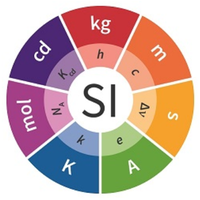Template:Base quantities and count
From Bioblast
Revision as of 14:30, 6 June 2020 by Gnaiger Erich (talk | contribs)
Base quantity Symbol for quantity Symbol for dimension Name of SI unit Symbol for SI unit [*] length l L meter m mass m M kilogram kg time t T second s electric current I I ampere A thermodynamic temperature T Θ kelvin K amount of substance *,§ nX = NX·NA-1 N mole mol count *,$ NX U counting unit x unit entity *,$ UX U counting unit x charge *,€ QX = NX·zX·e I·T coulomb C = A·s luminous intensity Iv J candela cd
- [*] »SI base units, except for x.
- * For the quantities n, N, U, and Q, the type X of the unit entity U has to be specified in the text and indicated by a subscript: nO2; Nce; QX.
- § 'Amount is a counting quantity, converting the counting unit [x] into moles [mol] using the Avogadro constant, NA.
- $ 'Count' equals the number of unit entities. In the SI, the quantity 'count' is explicitly considered as an exception: "Each of the seven base quantities used in the SI is regarded as having its own dimension. .. All other quantities, with the exception of counts, are derived quantities" (Bureau International des Poids et Mesures 2019 The International System of Units (SI)). A unit entity UE is not a count (UE is not a number of UE), but has the same dimension U and unit [x] as a count.
- € Charge is a derived SI quantity, included here for comparison. Charge is a counting quantity, converting the counting unit [x] into coulombs [C] using the elementary charge, e, or converting moles [mol] into coulombs [C] using the Faraday constant, F. zX is the charge number of entity X, which is a constant for any defined entity X. QX = nX·zX·F
